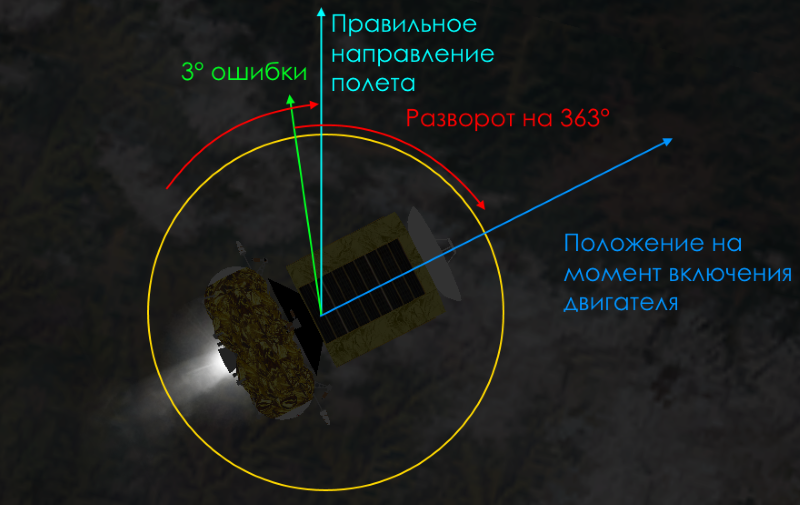On Tuesday, the
results of the work of the commission investigating the causes of the accident of the Fregat upper stage with Meteor-M No. 2-1 satellite were announced.
Guessing about what had happened , we followed the right track, but still we did not quite correctly picture the accident. And Anatoly Zak, who clearly
received an insider, also did not quite accurately relate the scenario of the incident. And having provided the commission’s conclusions with illustrations, we will finally get a complete picture of the course of events.
 Photo: Dmitry Lovetsky / Associated Press
Photo: Dmitry Lovetsky / Associated PressSteps
We already know that the plane of stabilization of a rocket in flight will pass diagonally through a rocket standing on the launch pad.
Explaining the picture again The angle between the north and the stabilization plane is called the azimuth of the start, and on the "East" it is 168.8 °. Before the launch of the rocket, two control systems were activated on it - the Soyuz-2.1b launch vehicle (hereinafter referred to as the SS launcher) and the upper stage “Fregat” (hereinafter SU of the Republic of Belarus). The rocket was supposed to fly a course of 354 °, and the upper stage, after separation from the third stage, was 344 °. Both control systems in normal flight should zero the azimuth. The rocket performs this maneuver from 5 to 22 seconds of flight, and the upper stage - after separation. RB had less than a minute to build orientation, because it was decided to launch it on an open path, and if the engine was not turned on quickly, then it would not have been possible to go into orbit. However, even before the start, the control systems decided to turn in different directions in order to move along the shortest path. SU RN decided to turn counterclockwise, because in this case it would have had to rotate the azimuth of 354 ° by 174 °. And it was more profitable for the accelerating unit to azimuth 344 ° to turn clockwise at an angle of 175 °.
 Angles are shown for clarity.
Angles are shown for clarity.Unfortunately, the upper stage only once, before the start, decided which way to turn it, and did not update the algorithm of its actions. As a result, when the rocket turned 174 degrees, they were added to the corner, which was going to turn the upper stage. At the time of separation, the error was 363 ° (174 ° + 175 ° = 349 °, obviously, not mentioned missile maneuvers were added), however, instead of recalculating the direction of motion, the upper stage went a long way. "Frigate" can rotate at a speed of up to one degree per second, and a minute before the engine was turned on, he managed to turn 55 degrees clockwise. The dialed speed of rotation led to the fact that within a minute of the first start of the engine the unit actually braked, and therefore fell before the third stage.
 Angles are shown for clarity.
Angles are shown for clarity.Protection from Murphy
In the accident that happened, the equipment was operational, and the flight mission was correct. I hope you have already understood that the version of the confused cosmodromes is completely untenable. The assumption that the large azimuth of the launch of the Vostochny cosmodrome is to blame is also incorrect. In fact, this is a manifestation of Murphy's law, as it is - if you have a 10 ° sector (3% of the full circle!) In which the control systems decide to turn in different directions, then you will build a launch site with such an azimuth of start to get into these most 3%. Separately, it is worth noting that if the Frigate were launched into a low orbit, it would have managed to turn around to an inadequate angle.
So what is the cause of the accident? Two words answer this question - “integration testing”. After creating individual modules or systems, it is imperative to verify that they will work together normally. The statement that the programmers who developed the Frigate software 20 years ago are to blame is also wrong - the program worked fine for the initial conditions, and it’s not worth hoping that it was immediately made for all possible launch sites.
Conclusion
There is nothing good in the accident, but still it is irrationally pleasant that it belongs to a complex and common type in space technology. These are not the extra tons of fuel filled in because of the mess in the documentation and materials not mixed up in the warehouse. For the same reason, poor integration testing in the atmosphere of Mars burned down the NASA Mars Climate Orbiter, and collapsed, losing control, the European Ariane 5 on its first flight. If in our cosmonautics the complexity of accidents will continue to grow, this will at least indicate that it has already coped with obvious and simple problems.